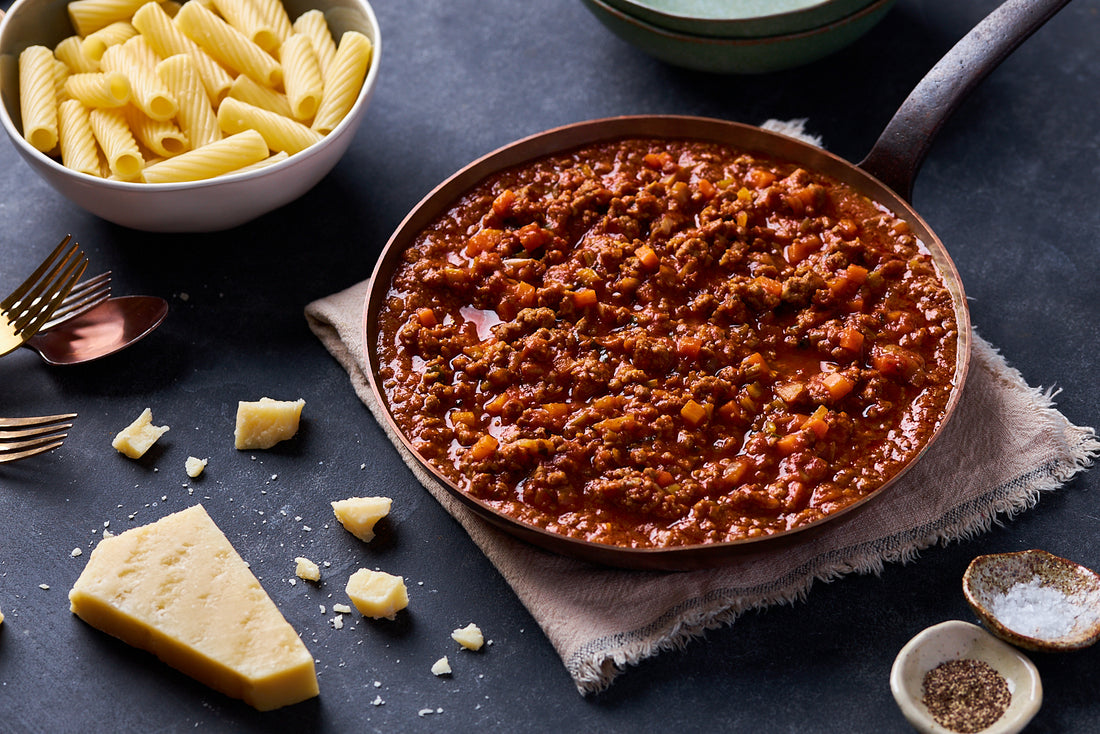It’s called ‘ragu alla Bolognese’, or ‘Bolognese sauce’ in English, but apparently we don’t even need to use the ‘Bolognese’ part. No, this is the Beyonce of pasta sauces. We’re in instantly recognisable one-word name superstar territory with this dish. In most of Italy, this meaty sauce is known simply as ‘ragu’ or ‘sauce’ – from the Latin verb that means ‘to stimulate the appetite’…. I think that’s all we need to hear!
WHY BOLOGNA?
Bologna is an ancient city and capital of the food-focused Emilia-Romagna region of northern Italy. Over the centuries this city in the fertile Po River Valley has acquired many nicknames. ‘La Grassa’ (‘The Fat’) refers to its rich cuisine – which makes us want to book a flight right now!
Its most famous speciality dishes are made using local cured meats, silky egg pasta, butter and Parmesan. It’s also called ‘the Learned City’ because, as well as having a world-famous pasta sauce, Bologna is home to the planet’s oldest university, established in 1088. Happy be the hungry student in Bologna!
BOLOGNESE OR BOLONEY?
The sauce called ‘ragu’ in Italy is substantially different from the Bolognese that we find in trattorias worldwide. In Bologna the sauce – made with a variety of different meats, often pork and veal as well as beef – is served primarily with tagliatelle, or any fresh wide ribbon pasta.
In fact, ragu dates back to the late 18th century, when the city’s culinary artisans started cooking up a sauce for the purpose of showing off their famous fresh pasta, particularly tagliatelle. The traditional recipe always involves ground meat, slow-cooked with aromatic vegetables, tomatoes and a touch of wine. A unique twist in traditional ragu Bolognese is that purists add a little milk during the cooking. It gives the sauce a velvety texture.
Serving ragu with spaghetti is considered decidedly odd… In Bolognese eyes that pasta is far too thin to hold the sauce properly. And, don’t ridicule boloney… it’s the slang name for Bologna sausage, derived from the Italian mortadella pork sausage and named after the city.
HOW DID BOLOGNESE CONQUER THE WORD?
The sauce’s journey beyond Italian borders began in earnest during the late 19th and early 20th centuries as Italian immigrants journeyed to new lands, carrying the flavours of Italy with them, including their beloved ragu. By the 20th century, with a surge in international travel and Italian restaurants, the rise of ragu Bolognese was unstoppable. It gained a reputation as a number one comfort food – and it still holds it!
A particular enthusiast was iconic chef Julia Child, whose charismatic passion for Italian food helped introduce it to countless American kitchens.
But one American who wasn’t won over was President Richard Nixon. During his 1969 presidential visit to Italy, famously meatloaf-addicted Nixon was taken to a restaurant in Bologna. Anticipation was running high for this state occasion. The ragu had been prepared and the chefs were at the ready… until the president ordered spaghetti with tomato sauce. Locals were astounded. After Bolognese-gate the president was viewed with distrust. What other poor decisions might this man make?!
HOW DO YOU EAT YOUR BOLOGNESE?
‘Well, obviously not with spaghetti,’ we all now murmur, knowledgably. That’s right – those rich meaty chunks can be folded much more successfully into a wider ribbon pasta. And with plenty of top-class Parmigiano grated over the top, of course.
Other easy suggestions for serving your Bolognese:
Over polenta (creamy or baked);
Layered into lasagne, a pasta bake, or moussaka;
Spooned into a jacket potato, toped with Parmesan and maybe a dollop of pesto;
Toasted in a jaffle with grated tasty cheese;
Got leftover risotto? Roll into balls, fill with ragu and pan-fry to make arancini;
Fold ragu into leftover cooked rice, stuff into a hollowed capsicum, tomato or zucchini and oven bake;
Spread in a small oven dish and break a couple of eggs into hollow. Oven bake – like a meaty shakshuka;
Cook in pastry to make empanadas, or individual pies.
Shop our delicious Beef Bolognese here.
If you liked this, you might also like:
Paleo lasagne recipe
Barbecue secrets with Chef Josh
A forkful of travel
